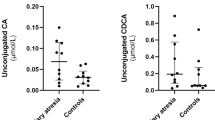Summary
Ursodeoxycholic acid therapy (600 mg/day) was evaluated in twelve patients with nonadvanced chronic cholestasis. Within four months, ursodeoxycholic acid replaced more than 50% of total bile acids in 8 patients and the reduction of serum γ-glutamyltranspeptidase, alkaline phosphatase and transaminases averaged 30% or more. The serum levels of chenodeoxycholic acid depend on those of ursodeoxycholic acid, but are not related to those of biochemical parameters. Drug therapy was continued in three poor responders for 2–3 four-month periods. In one case an increase of the serum proportion of ursodeoxycholic acid was associated with a reduction in biochemical parameters. The other two cases had high serum levels of chenodeoxycholic acid and/or cholic acid throughout the entire course of treatment. While the treatment of chronic cholestasis requires an effectual serum proportion of ursodeoxycholic acid, it is important to distinguish endogenous persistent hyper-bile-acidemia from ursodeoxycholic acid-related acidemia.
Similar content being viewed by others
References
Jain S, Scheuer PJ, Samourian S, et al: A controlled trial of D-penicillamine in primary biliary cirrhosis. Lancet 1977;l:831–834.
Crowe J, Christensen E, Smith M, et al: Azathioprine in primary biliary cirrhosis: a preliminary report of an international trial. Gastroenterology 1980;78:1005–1010.
Kaplan MM, Ailing DW, Zimmerman HJ, et al: A prospective trial of colchicine for primary biliary cirrhosis. Gastroenterology 1986;92:255–257.
Fischer MM, Paradine ME: Influence of ursodeoxycholic acid (UDCA) on biochemical parameters in cholestatic liver disease (abstr). Gastroenterology 1986; 90:1725.
Poupon R, Chretien Y, Poupon RE, et al: Is ursodeoxycholic acid an effective treatment for primary biliary cirrhosis? Lancet 1987;2:834–836.
Wada T, Koga Y, Yoshitake M, et al: Effect of UDCA on primary biliary cirrhosis. Clin Res 1987;64:2590–2594.
Okuyama S, Higuchi T, Ichimiya H, et al: A case of primary biliary cirrhosis: 4 year’s treatment with 300 mg/day ursodeoxycholic acid. Acta Hepat Jap 1988;29:799–802. (in Japanese)
Stiehl A, Raedsch B, Kommerell B: The effect of ursodeoxycholic acid (URSO) in primary sclerosing cholangitis. A comparison to primary biliary cirrhosis (abstr). Gastroenterology 1988; 94:A595.
Leuschner U, Fischer H, Kurtz W, et al: Ursodeoxycholic acid in primary biliary cirrhosis: results of a controlled double-blind trial. Gastroenterology 1989;97:1268–1274.
Batta AK, Salen G, Arora R, et al: Effect of ursodeoxycholic acid metabolism in primary biliary cirrhosis. Hepatology 1989; 10:414–419.
Hofmann AF, Popper H: Ursodeoxycholic acid for primary biliary cirrhosis. Lancet 1987;2:398–399.
Salen G, Tint GS, Eliav B, et al: Increased formation of ursodeoxycholic acid in patients treated with chenodeoxycholic acid. J Clin Invest 1974;53:612–621.
Hirano S, Masuda N, Oda H. In vitro transformation of chenodeoxycholic acid and ursodeoxycholic acid by human intestinal flora, with particular reference to the mutual conversion between the two bile acids. J Lipid Res 1981;22:735–743.
Nilsell K, Angelin B, Leijd B, et al: Comparative effects of ursodeoxycholic acid and chenodeoxycholic acid on bile acid kinetics and biliary lipid secretion in humans: evidence for different models of action on bile acid synthesis. Gastroenterology 1983;85:1248–1256.
Scheuer JP: Liver biopsy interpretation. London: Bailliére Tindall. 1988;40-65.
LiYeng C, Goldberg HI: Sclerosing cholangitis: broad spectrum of radiographic features. Gastrointest Radiol 1984;9:39–47.
Okuyama S, Kokubun N, Higashidate S, et al: A new analytical method of individual bile acids using high performance liquid chromatography and immobilized 3α-hydroxysteroid dehydrogenase in column form. Chem Lett. 1979;1443-1446.
Kitani K, Kanai S: Tauroursodeoxycholate prevents taurocholate induced cholestasis. Life Sci 1982;30:515–523.
Kitani K, Kitani S: Effect of ursodeoxycholate on the bile flow in the rat. Life Sci 1982;31:1973–1985.
Miyazaki K, Nakayama F, Koga A: Effect of chenodeoxycholic and ursodeoxycholic acids on isolated human hepatocytes. Dig Dis Sci 1984;19:1123–1130.
Yamanaka M, Ohto M, Obata H, et al: Ursodeoxycholic acid for treatment of chronic hepatitis. A double-blind controlled study. Diag Treat 1976;64:2150–2157.
Leuschner U, Leuschner M, Sieratzki J, et al: Gallstone dissolution with ursodeoxycholic acid in patient with chronic active hepatitis and two years follow-up. A pilot study. Dig Dis Sci 1985;30:642–649.
Bellentani S, Tabarroni G, Barchi T, et al: Effect of ursodeoxycholic acid treatment on alanine aminotransferase and γ-glutamyl-transpeptidase serum levels in patients with hypertransaminasemia. Results from a double-blind controlled trial. J Hepatology 1989;8:7–12.
Tokyo Cooperative Gallstone Study Group: Efficacy and indications of ursodeoxycholic acid treatment for dissolving gallstones: a multicenter double-blind trial. Gastroenterology 1980;78:542–548.
Author information
Authors and Affiliations
Rights and permissions
About this article
Cite this article
Higuchi, T., Hishida, N., Isomura, T. et al. The effectual level of ursodeoxycholic acid in therapy for non-advanced chronic cholestasis is fifty percent of total serum bile acids. Gastroenterol Jpn 27, 222–229 (1992). https://doi.org/10.1007/BF02777726
Received:
Accepted:
Issue Date:
DOI: https://doi.org/10.1007/BF02777726




